科技英语阅读 第五单元文章翻译
- 格式:doc
- 大小:29.50 KB
- 文档页数:2
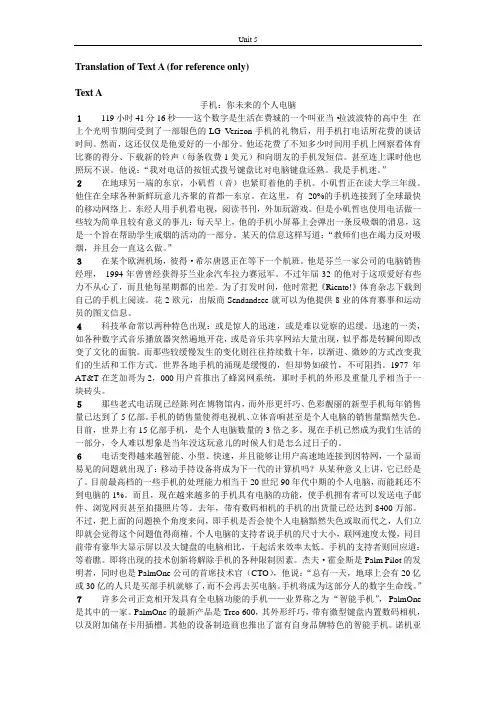
Translation of Text A (for reference only)Text A手机:你未来的个人电脑1119小时41分16秒——这个数字是生活在费城的一个叫亚当·拉波波特的高中生在上个光明节期间受到了一部银色的LG Verizon手机的礼物后,用手机打电话所花费的谈话时间。
然而,这还仅仅是他爱好的一小部分。
他还花费了不知多少时间用手机上网察看体育比赛的得分、下载新的铃声(每条收费1美元)和向朋友的手机发短信。
甚至连上课时他也照玩不误。
他说:“我对电话的按钮式拨号键盘比对电脑键盘还熟。
我是手机迷。
”2在地球另一端的东京,小矶哲(音)也紧盯着他的手机。
小矶哲正在读大学三年级。
他住在全球各种新鲜玩意儿齐聚的首都—东京。
在这里,有20%的手机连接到了全球最快的移动网络上。
东经人用手机看电视,阅读书刊,外加玩游戏。
但是小矶哲也使用电话做一些较为简单且较有意义的事儿:每天早上,他的手机小屏幕上会弹出一条反吸烟的消息,这是一个旨在帮助学生戒烟的活动的一部分。
某天的信息这样写道:“教师们也在竭力反对吸烟,并且会一直这么做。
”3在某个欧洲机场,彼得·希尔唐恩正在等下一个航班。
他是芬兰一家公司的电脑销售经理,1994年曾曾经获得芬兰业余汽车拉力赛冠军。
不过年届32的他对于这项爱好有些力不从心了,而且他每星期都的出差。
为了打发时间,他时常把《Riento!》体育杂志下载到自己的手机上阅读。
花2欧元,出版商Sendandsee就可以为他提供8业的体育赛事和运动员的图文信息。
4科技革命常以两种特色出现:或是惊人的迅速,或是难以觉察的迟缓。
迅速的一类,如各种数字式音乐播放器突然遍地开花,或是音乐共享网站大量出现,似乎都是转瞬间即改变了文化的面貌。
而那些较缓慢发生的变化则往往持续数十年,以渐进、微妙的方式改变我们的生活和工作方式。
世界各地手机的涌现是缓慢的,但却势如破竹,不可阻挡。
1977年AT&T在芝加哥为2,000用户首推出了蜂窝网系统,那时手机的外形及重量几乎相当于一块砖头。
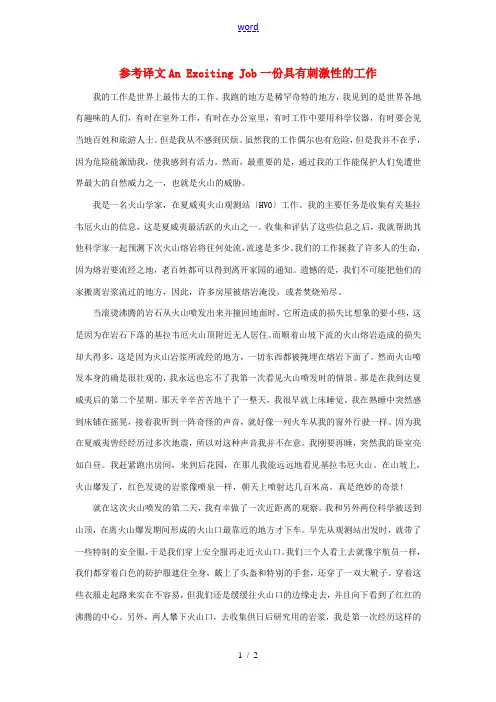
参考译文An Exciting Job一份具有刺激性的工作我的工作是世界上最伟大的工作。
我跑的地方是稀罕奇特的地方,我见到的是世界各地有趣味的人们,有时在室外工作,有时在办公室里,有时工作中要用科学仪器,有时要会见当地百姓和旅游人士。
但是我从不感到厌烦。
虽然我的工作偶尔也有危险,但是我并不在乎,因为危险能激励我,使我感到有活力。
然而,最重要的是,通过我的工作能保护人们免遭世界最大的自然威力之一,也就是火山的威胁。
我是一名火山学家,在夏威夷火山观测站〔HVO〕工作。
我的主要任务是收集有关基拉韦厄火山的信息,这是夏威夷最活跃的火山之一。
收集和评估了这些信息之后,我就帮助其他科学家一起预测下次火山熔岩将往何处流,流速是多少。
我们的工作拯救了许多人的生命,因为熔岩要流经之地,老百姓都可以得到离开家园的通知。
遗憾的是,我们不可能把他们的家搬离岩浆流过的地方,因此,许多房屋被熔岩淹没,或者焚烧殆尽。
当滚烫沸腾的岩石从火山喷发出来并撞回地面时,它所造成的损失比想象的要小些,这是因为在岩石下落的基拉韦厄火山顶附近无人居住。
而顺着山坡下流的火山熔岩造成的损失却大得多,这是因为火山岩浆所流经的地方,一切东西都被掩埋在熔岩下面了。
然而火山喷发本身的确是很壮观的,我永远也忘不了我第一次看见火山喷发时的情景。
那是在我到达夏威夷后的第二个星期。
那天辛辛苦苦地干了一整天,我很早就上床睡觉。
我在熟睡中突然感到床铺在摇晃,接着我听到一阵奇怪的声音,就好像一列火车从我的窗外行驶一样。
因为我在夏威夷曾经经历过多次地震,所以对这种声音我并不在意。
我刚要再睡,突然我的卧室亮如白昼。
我赶紧跑出房间,来到后花园,在那儿我能远远地看见基拉韦厄火山。
在山坡上,火山爆发了,红色发烫的岩浆像喷泉一样,朝天上喷射达几百米高。
真是绝妙的奇景!就在这次火山喷发的第二天,我有幸做了一次近距离的观察。
我和另外两位科学被送到山顶,在离火山爆发期间形成的火山口最靠近的地方才下车。
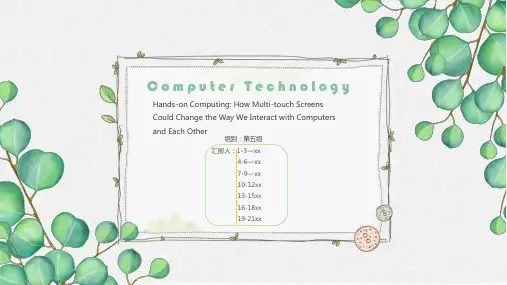
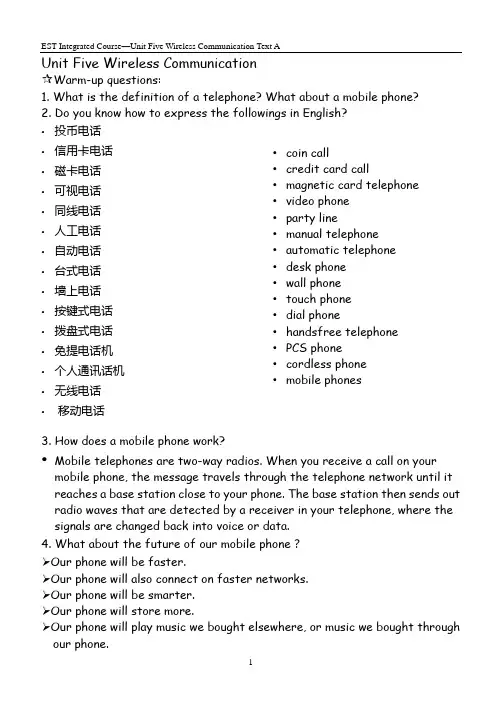
✩Warm-up questions:1. What is the definition of a telephone? What about a mobile phone?2. Do you know how to express the followings in English?•投币电话•信用卡电话•磁卡电话•可视电话•同线电话•人工电话•自动电话•台式电话•墙上电话•按键式电话•拨盘式电话•免提电话机•个人通讯话机•无线电话•移动电话•coin call•credit card call •magnetic card telephone •video phone•party line•manual telephone •automatic telephone •desk phone•wall phone•touch phone•dial phone•handsfree telephone •PCS phone•cordless phone •mobile phones3. How does a mobile phone work?•Mobile telephones are two-way radios. When you receive a call on your mobile phone, the message travels through the telephone network until it reaches a base station close to your phone. The base station then sends out radio waves that are detected by a receiver in your telephone, where the signals are changed back into voice or data.4. What about the future of our mobile phone?Our phone will be faster.Our phone will also connect on faster networks.Our phone will be smarter.Our phone will store more.Our phone will play music we bought elsewhere, or music we bought through our phone.Video phones won't look like baseball bats.TV is coming.Text A Your Next ComputerText Organization (p.144)- Five PartsPart One Paras. 1-3 Part Two Paras. 4-5Part Three Paras. 6-9 Part Four Paras. 10-12Part Five Paras. 13-14✩Part One Paras. 1-3Now people spend cou ntless / many hours using their mobile phone‘s Internet connection to download, check or send messages .Obsolete (L. 3 –introduction) a. no longer in use or no longer useful 已废弃的,过时的Eg.公司计划淘汰这些设备,因为它们已经报废了。
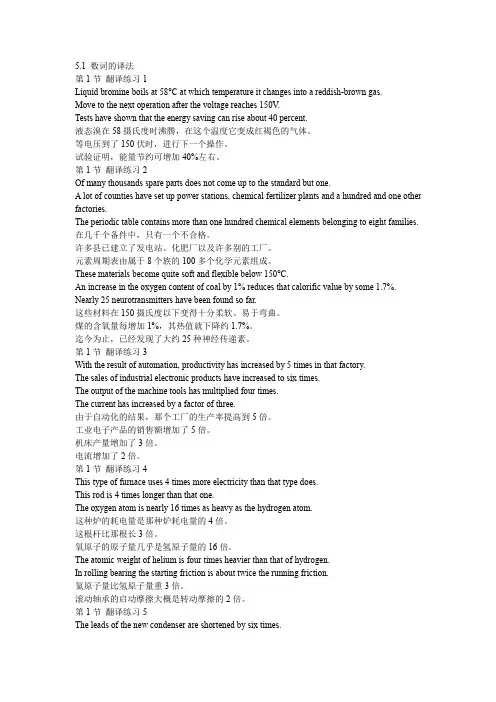
5.1 数词的译法第1节翻译练习1Liquid bromine boils at 58°C at which temperature it changes into a reddish-brown gas.Move to the next operation after the voltage reaches 150V.Tests have shown that the energy saving can rise about 40 percent.液态溴在58摄氏度时沸腾,在这个温度它变成红褐色的气体。
等电压到了150伏时,进行下一个操作。
试验证明,能量节约可增加40%左右。
第1节翻译练习2Of many thousands spare parts does not come up to the standard but one.A lot of counties have set up power stations, chemical fertilizer plants and a hundred and one other factories.The periodic table contains more than one hundred chemical elements belonging to eight families. 在几千个备件中,只有一个不合格。
许多县已建立了发电站、化肥厂以及许多别的工厂。
元素周期表由属于8个族的100多个化学元素组成。
These materials become quite soft and flexible below 150°C.An increase in the oxygen content of coal by 1% reduces that calorific value by some 1.7%. Nearly 25 neurotransmitters have been found so far.这些材料在150摄氏度以下变得十分柔软、易于弯曲。
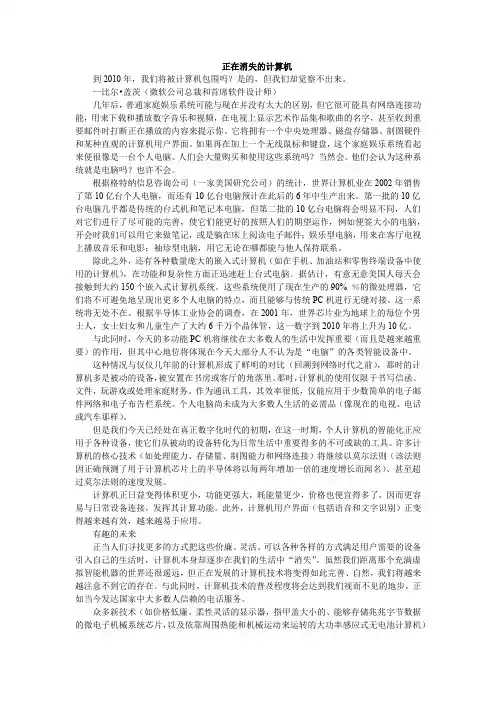
正在消失的计算机到2010年,我们将被计算机包围吗?是的,但我们却觉察不出来。
—比尔•盖茨(微软公司总裁和首席软件设计师)几年后,普通家庭娱乐系统可能与现在并没有太大的区别,但它很可能具有网络连接功能,用来下载和播放数字音乐和视频,在电视上显示艺术作品集和歌曲的名字,甚至收到重要邮件时打断正在播放的内容来提示你。
它将拥有一个中央处理器、磁盘存储器、制图硬件和某种直观的计算机用户界面。
如果再在加上一个无线鼠标和键盘,这个家庭娱乐系统看起来便很像是一台个人电脑。
人们会大量购买和使用这些系统吗?当然会。
他们会认为这种系统就是电脑吗?也许不会。
根据格特纳信息咨询公司(一家美国研究公司)的统计,世界计算机业在2002年销售了第10亿台个人电脑,而还有10亿台电脑预计在此后的6年中生产出来。
第一批的10亿台电脑几乎都是传统的台式机和笔记本电脑,但第二批的10亿台电脑将会明显不同,人们对它们进行了尽可能的完善,使它们能更好的按照人们的期望运作,例如便签大小的电脑,开会时我们可以用它来做笔记,或是躺在床上阅读电子邮件;娱乐型电脑,用来在客厅电视上播放音乐和电影;袖珍型电脑,用它无论在哪都能与他人保持联系。
除此之外,还有各种数量庞大的嵌入式计算机(如在手机、加油站和零售终端设备中使用的计算机),在功能和复杂性方面正迅速赶上台式电脑。
据估计,有意无意美国人每天会接触到大约150个嵌入式计算机系统。
这些系统使用了现在生产的90% %的微处理器,它们将不可避免地呈现出更多个人电脑的特点,而且能够与传统PC机进行无缝对接。
这一系统将无处不在。
根据半导体工业协会的调查,在2001年,世界芯片业为地球上的每位个男士人,女士妇女和儿童生产了大约6千万个晶体管,这一数字到2010年将上升为10亿。
与此同时,今天的多功能PC机将继续在大多数人的生活中发挥重要(而且是越来越重要)的作用,但其中心地位将体现在今天大部分人不认为是“电脑”的各类智能设备中。
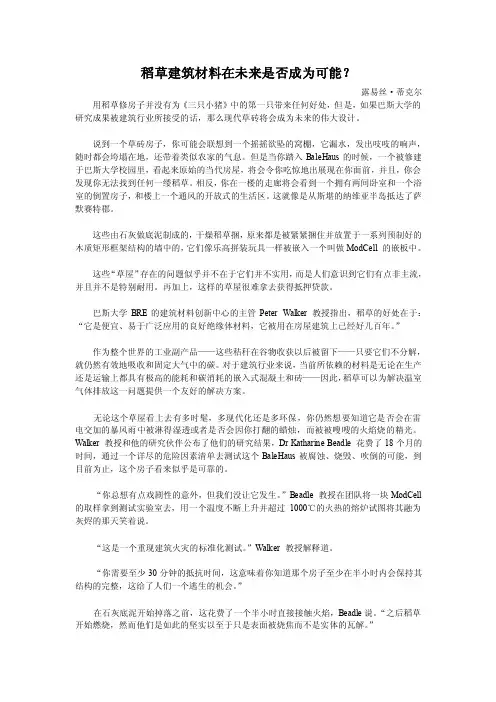
稻草建筑材料在未来是否成为可能?露易丝·蒂克尔用稻草修房子并没有为《三只小猪》中的第一只带来任何好处,但是,如果巴斯大学的研究成果被建筑行业所接受的话,那么现代草砖将会成为未来的伟大设计。
说到一个草砖房子,你可能会联想到一个摇摇欲坠的窝棚,它漏水,发出吱吱的响声,随时都会垮塌在地,还带着类似农家的气息。
但是当你踏入BaleHaus的时候,一个被修建于巴斯大学校园里,看起来原始的当代房屋,将会令你吃惊地出展现在你面前,并且,你会发现你无法找到任何一缕稻草。
相反,你在一楼的走廊将会看到一个拥有两间卧室和一个浴室的倒置房子,和楼上一个通风的开放式的生活区。
这就像是从斯堪的纳维亚半岛抵达了萨默赛特郡。
这些由石灰做底泥制成的,干燥稻草捆,原来都是被紧紧捆住并放置于一系列预制好的木质矩形框架结构的墙中的,它们像乐高拼装玩具一样被嵌入一个叫做ModCell 的嵌板中。
这些“草屋”存在的问题似乎并不在于它们并不实用,而是人们意识到它们有点非主流,并且并不是特别耐用。
再加上,这样的草屋很难拿去获得抵押贷款。
巴斯大学BRE的建筑材料创新中心的主管Peter Walker 教授指出,稻草的好处在于:“它是便宜、易于广泛应用的良好绝缘体材料,它被用在房屋建筑上已经好几百年。
”作为整个世界的工业副产品——这些秸秆在谷物收获以后被留下——只要它们不分解,就仍然有效地吸收和固定大气中的碳。
对于建筑行业来说,当前所依赖的材料是无论在生产还是运输上都具有极高的能耗和碳消耗的嵌入式混凝土和砖——因此,稻草可以为解决温室气体排放这一问题提供一个友好的解决方案。
无论这个草屋看上去有多时髦,多现代化还是多环保,你仍然想要知道它是否会在雷电交加的暴风雨中被淋得湿透或者是否会因你打翻的蜡烛,而被被嗖嗖的火焰烧的精光。
Walker 教授和他的研究伙伴公布了他们的研究结果,Dr Katharine Beadle 花费了18个月的时间,通过一个详尽的危险因素清单去测试这个BaleHaus被腐蚀、烧毁、吹倒的可能,到目前为止,这个房子看来似乎是可靠的。
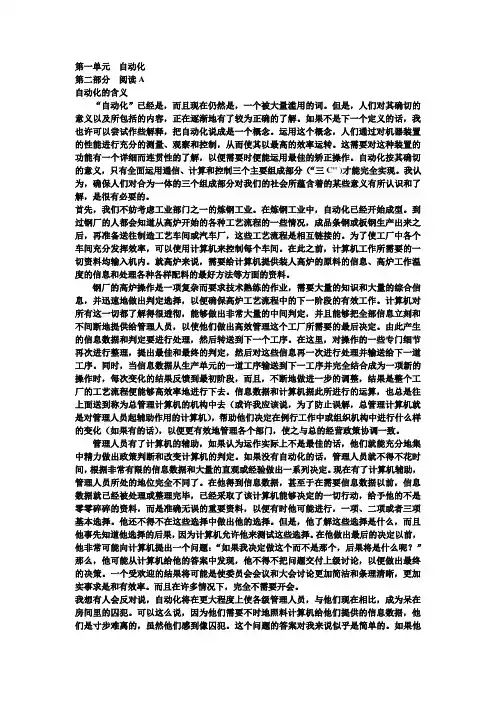
第一单元自动化第二部分阅读A自动化的含义“自动化”已经是,而且现在仍然是,一个被大量滥用的词。
但是,人们对其确切的意义以及所包括的内容,正在逐渐地有了较为正确的了解。
如果不是下一个定义的话,我也许可以尝试作些解释,把自动化说成是一个概念。
运用这个概念,人们通过对机器装置的性能进行充分的测量、观察和控制,从而使其以最高的效率运转。
这需要对这种装置的功能有一个详细而连贯性的了解,以便需要时便能运用最佳的矫正操作。
自动化按其确切的意义,只有全面运用通信、计算和控制三个主要组成部分(“三C" )才能完全实现。
我认为,确保人们对合为一体的三个组成部分对我们的社会所蕴含着的某些意义有所认识和了解,是很有必要的。
首先,我们不妨考虑工业部门之一的炼钢工业。
在炼钢工业中,自动化已经开始成型。
到过钢厂的人都会知道从高炉开始的各种工艺流程的一些情况,成品条钢或板钢生产出来之后,再准备送往制造工艺车间或汽车厂,这些工艺流程是相互链接的。
为了使工厂中各个车间充分发挥效率,可以使用计算机来控制每个车间。
在此之前,计算机工作所需要的一切资料均输入机内。
就高炉来说,需要给计算机提供装人高炉的原料的信息、高炉工作温度的信息和处理各种各样配料的最好方法等方面的资料。
钢厂的高炉操作是一项复杂而要求技术熟练的作业,需要大量的知识和大量的综合信息,并迅速地做出判定选择,以便确保高炉工艺流程中的下一阶段的有效工作。
计算机对所有这一切都了解得很透彻,能够做出非常大量的中间判定,并且能够把全部信息立刻和不间断地提供给管理人员,以使他们做出高效管理这个工厂所需要的最后决定。
由此产生的信息数据和判定要进行处理,然后转送到下一个工序。
在这里,对操作的一些专门细节再次进行整理,提出最佳和最终的判定,然后对这些信息再一次进行处理并输送给下一道工序。
同时,当信息数据从生产单元的一道工序输送到下一工序并完全结合成为一项新的操作时,每次变化的结果反馈到最初阶段,而且,不断地做进一步的调整,结果是整个工厂的工艺流程便能够高效率地进行下去。
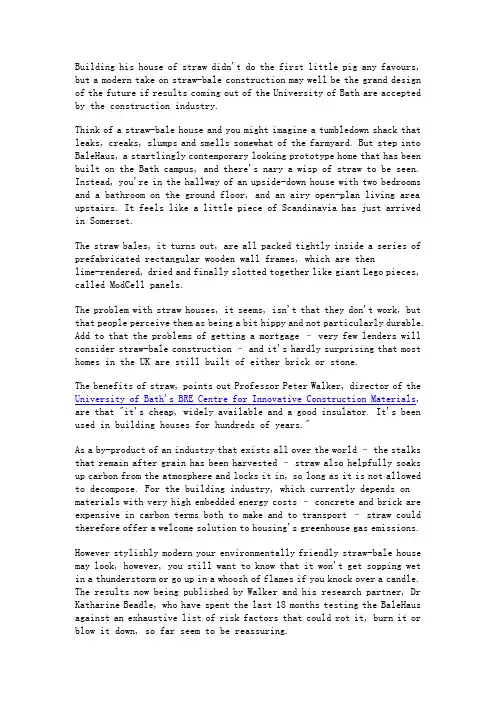
Building his house of straw didn't do the first little pig any favours, but a modern take on straw-bale construction may well be the grand design of the future if results coming out of the University of Bath are accepted by the construction industry.Think of a straw-bale house and you might imagine a tumbledown shack that leaks, creaks, slumps and smells somewhat of the farmyard. But step into BaleHaus, a startlingly contemporary looking prototype home that has been built on the Bath campus, and there's nary a wisp of straw to be seen. Instead, you're in the hallway of an upside-down house with two bedrooms and a bathroom on the ground floor, and an airy open-plan living area upstairs. It feels like a little piece of Scandinavia has just arrived in Somerset.The straw bales, it turns out, are all packed tightly inside a series of prefabricated rectangular wooden wall frames, which are thenlime-rendered, dried and finally slotted together like giant Lego pieces, called ModCell panels.The problem with straw houses, it seems, isn't that they don't work, but that people perceive them as being a bit hippy and not particularly durable. Add to that the problems of getting a mortgage – very few lenders will consider straw-bale construction –and it's hardly surprising that most homes in the UK are still built of either brick or stone.The benefits of straw, points out Professor Peter Walker, director of the University of Bath's BRE Centre for Innovative Construction Materials, are that "it's cheap, widely available and a good insulator. It's been used in building houses for hundreds of years."As a by-product of an industry that exists all over the world –the stalks that remain after grain has been harvested –straw also helpfully soaks up carbon from the atmosphere and locks it in, so long as it is not allowed to decompose. For the building industry, which currently depends on materials with very high embedded energy costs –concrete and brick are expensive in carbon terms both to make and to transport – straw could therefore offer a welcome solution to housing's greenhouse gas emissions.However stylishly modern your environmentally friendly straw-bale house may look, however, you still want to know that it won't get sopping wet in a thunderstorm or go up in a whoosh of flames if you knock over a candle. The results now being published by Walker and his research partner, Dr Katharine Beadle, who have spent the last 18 months testing the BaleHaus against an exhaustive list of risk factors that could rot it, burn it or blow it down, so far seem to be reassuring."You always want a bit of drama, but we didn't get it!" laughs Beadle of the day the team took a ModCell unit to a test laboratory and tried to reduce it to ashes by strapping it to a fiery furnace and raising the temperature to over 1,000C."It's a standard test to replicate a fire in a building," explains Walker."You want a minimum of 30 minutes' resistance; that means you know that a house will at least retain its structural integrity for half an hour, which gives people a chance to get out."It took an hour-and-a-half of being in direct contact with the flames, says Beadle, before the lime render began to drop off, "and then the straw did start to burn back, but because it's so compacted it suffered more charring than actual disintegration."After waiting another 45 minutes and finding that the panel still hadn't failed, the team gave up and stopped the experiment, secure in the knowledge that the material had performed way beyond the requirements of building regulations.When it came to blowing the house down – hydraulic jacks were placed against the walls to replicate wind forces pushing against the bales –the ModCell panels moved a few millimetres, but stayed within the tolerances allowed for by the computer modelling carried out prior to its construction.That, says Walker, could be very good news for the price of the eventual ModCell building system."It means the house is stiffer than it needs to be, so we now have the option of taking away some of that stiffness – ie, reduce its internal timber – and that could reduce the cost."The approximate cost of the current modular building system for this de sign is £132,000 from above the concrete slab. For a smallishtwo-bedroomed house with one large open-plan kitchen/diner, that doesn't seem particularly cheap given that straw is supposed to be inexpensive, and you'd still have to buy the plot and dig the foundations."Cost is a challenge to the introduction of this technology, but as a prototype house I think it stacks up well," says Walker."The aspiration is that it should be cost-competitive, with more savings coming through reduced heating bills."To replicate the heat given off by humans and appliances, arrays of incandescent lightbulbs on timers blaze in every room at pre-programmed times of day "to see how much heat escapes, and what level of heating would be needed at different times of year," explains Beadle."That environmental modelling will give us all the numbers about the energy the house is predicted to use. And if we are predicting how it will operate given climate change, we can then put in those variables."Sensors embedded within each wall panel constantly monitor the degree of moisture absorbed and then released back through the breathable lime render into the air outside by the panels. And on the airtightness test that was carried out, BaleHaus came in way under the building regulations threshold, and did considerably better than the far lower "best practice" standard.Next up is going to be the flood test. Disappointingly, the researchers aren't simply going to leave the bath taps running: instead, they'll stand a panel in a metre of water, measure how long it takes to dry out and assess whether using industrial dryers causes damage to the straw."Longer term, we'd like to maybe get some people to live in it, a family of three or four perhaps, and see how it performs in a real-life situation," says Walker.Student accommodation, I wonder? Walker suddenly looks a bit concerned for his straw-bale baby, so probably only mature, well-behaved responsible students who will promise no rampaging house parties should apply. But who knows when the first straw-bale halls of residence will be built for students desperate for some decent, earth-friendly and thermally efficient digs?bre。

高等学校英语拓展系列教程-科技英语阅读课文翻译Text AUnit2 The Future of Alternative Energy替代能源的前景Residential energy use in the United States will increase 25 percent by the year 2025, according to U.S. Department of Energy (DOE) forecasts. A small but increasing share of that extra power will trickle in from renewable sources like wind, sunlight, water and heat in the ground.美国能源部(DOE)预测,美国居民所使用的能源将在2025 年前增加25%。
增加的电能中将有一小部分来源于再生能源(如风、阳光、水、地热),而且这部分还会不断增大。
Last year alternative e nergy sources provided 6 percent of the nation’s energy supply, according to the DOE.美国能源部称,去年全国能源供应总量中有6%来自于替代能源。
“The future belongs to renewable energy,” said Brad Collins, the executive director of the American Solar Energy Society, a Boulder, Colorado-based nonprofit organization. “Scientist and industry experts may disagree over how long the world’s supply of oil and natural gas will last, but it will end,” Collin said.“未来属于再生能源,”美国太阳能协会执行主席布拉德·柯林斯说。
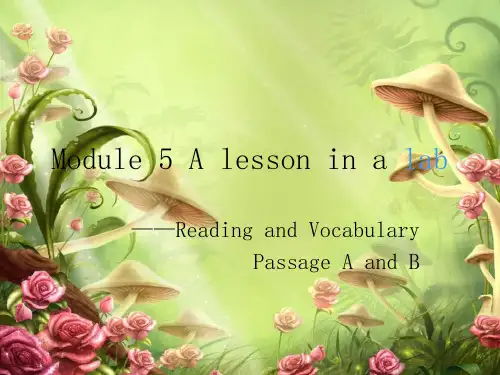
Unit 5Science and the Scientific AttitudeScience is the body of knowledge about nature that represents the collective efforts, insights, findings, and wisdom of the human race. Science is not something new but had its beginnings before recorded history when humans first discovered reoccurring relationships around them. Through careful observations of these relationships, they began to know nature and, because of nature's dependability, found they could make predictions to enable some control over their surroundings.Science made its greatest headway in the sixteenth century when people began asking answerable questions about nature -- when they began replacing superstition by a systematic search for order -- when experiment in addition to logic was used to test ideas. Where people once tried to influence natural events with magic and supernatural forces, they now had science to guide them. Advance was slow, however, because of the powerful opposition to scientific methods and ideas.In about 1510 Copernicus suggested that the sun was stationary and that the earth revolved about the sun. He refuted the idea that the earth was the center of the universe. After years of hesitation, he published his findings but died before his book was circulated. His book was considered heretical and dangerous and was banned by the Church for 200 years. A century after Copernicus, the mathematician Bruno was burned at the stake -- largely for supporting Copernicus, suggesting the sun to be a star, and suggesting that space was infinite. Galileo was imprisoned for popularizing the Copernican theory and for his other contributions to scientific thought. Yet a couple of centuries later, Copernican advocates seemed harmless.This happens age after age. In the early 1800s geologists met with violent condemnation because they differed with the Genesis account of creation. Later in the same century, geology was safe, but theories of evolution were condemned and the teaching of them forbidden. This most likely continues. "At every crossway on the road that leads to the future, each progressive spirit is opposed by a thousand men appointed to guard the past." Every age has one or more groups of intellectual rebels who are persecuted, condemned, or suppressed at the time; but to a later age, they seem harmless and often essential to the elevation of human conditions.The enormous success of science has led to the general belief that scientists have developed and ate employing a "method" - a method that is extremely effective in gaining, organizing, and applying new knowledge. Galileo, famous scientist of the 1600s, is usuallycredited with being the "Father of the Scientific Method." His method is essentially as follows:1. Recognize a problem.2. Guess an answer.3. Predict the consequences of the guess.4. Perform experiments to test predictions.5. Formulate the simplest theory organizes the three main ingredients: guess, prediction, experimental outcome.Although this cookbook method has a certain appeal, to has not been the key to most of the breakthroughs and discoveries in science. Trial and error, experimentation without guessing, accidental discovery, and other methods account for much of the progress in science. Rather than a particular method, the success of science has more to do with an attitude common to scientists. This attitude is essentially one of inquiry, experimentation, and humility before the facts. If a scientist holds an idea to be true and finds any counterevidence whatever, the idea is either modified or abandoned. In the scientific spirit, the idea must be modified or abandoned in spite of the reputation of the person advocating it. As an example, the greatly respected Greek philosopher Aristotle said that falling bodies fall at a speed proportional to their weight. This false idea was held to be true for more than 2,000 years because of Aristotle's immense authority. In the scientific spirit, however, a single verifiable experiment to the contrary outweighs any authority, regardless of reputation or the number of followers and advocates.Scientists must accept facts even when they would like them to be different. They must strive to distinguish between what they see and what they wish to see -- for humanity's capacity for self-deception is vast. People have traditionally tended to adopt general rules, beliefs, creeds, theories, and ideas without thoroughly questioning their validity and to retain them long after they have been shown to be meaningless, false, or at least questionable. The most widespread assumptions are the least questioned. Most often, when an idea is adopted, particular attention is given to cases that seem to support it, while cases that seem to refute it are distorted, belittled, or ignored. We feel deeply that it is a sign of weakness to "change out minds." Competent scientists, however, must be expert at changing their minds. This is because science seeks not to defend our beliefs but to improve them. Better theories are made by those who are not hung up on prevailing ones.Away from their profession, scientists are inherently no more honest or ethical than other people. But in their profession they work in an arena that puts a high premium onhonesty. The cardinal rule in science is that all claims must be testable -- they must be capable, at least in principle, of being proved wrong. For example, if someone claims that a certain procedure has a certain result, it must in principle be possible to perform a procedure that will either confirm or contradict the claim. If confirmed, then the claim is regarded as useful and a stepping-stone to further knowledge. None of us has the time or energy or resources to test every claim, so most of the time we must take somebody's word. However, we must have some criterion for deciding whether one person's word is as good as another's and whether one claim is as good as another. The criterion, again, is that the claim must be testable. To reduce the likelihood of error, scientists accept the word only of those whose ideas, theories, and findings are testable -- if not in practice then at least in principle. Speculations that cannot be tested are regarded as "unscientific." This has the long-run effect of compelling honesty - findings widely publicized among fellow scientists are generally subjected to further testing. Sooner or later, mistake (and lies) are bound to be found out; wishful thinking is bound to be exposed. The honesty so important to the progress of science thus becomes a matter of self-interest to scientists.科学与科学态度科学是关于自然的知识主体,代表了人类集体的努力,洞察力,新发现和智慧。
科技英语阅读1-9单元译文:Unit 1罗素悖论的提出是基于这样的一个事例:设想有这样一群理发师,他们只给不给自己理发的人理发。
假设其中一个理发师符合上述的条件,不给自己理发;然而按照要求,他必须要给自己理发。
但是在这个集合中没有人会给自己理发。
(如果这样的话,这个理发师必定是给别人理发还要给自己理发)1901年,伯特兰·罗素悖论的发现打击了他其中的一个数学家同事。
在19世纪后期,弗雷格尝试发展一个基本原理以便数学上能使用符号逻辑。
他确立了形式表达式(如:x =2)和数学特性(如偶数)之间的联系。
按照弗雷格理论的发展,我们能自由的用一个特性去定义更多更深远的特性。
1903年,发表在《数学原理》上的罗素悖论从根本上揭示了弗雷格这种集合系统的局限性。
就现在而言,这种类型的集合系统能很好的用俗称集的结构式来描述。
例如,我们可以用 x代表整数,通过n 来表示并且n大于3小于7,来表示4,5,6这样一个集合。
这种集合的书写形势就是:x={n:n是整数,3<n<7}。
集合中的对象并不一定是数字。
我们也可让y={x:x是美国的一个男性居民}。
表面上看,似乎任何一个关于x的描述都有一个符合要求的空间。
但是,罗素(和策梅洛一起)发现x={a:a不再a中}导致一个矛盾,就像对一群理发师的描述一样。
x它本身是在x的集合中吗?否定的答案导致了矛盾的出现。
当罗素发现了悖论,弗雷格立即就发现悖论对他的理论有致命的打击。
尽管这样,他还不能解决这个问题,并且上世纪有很多的尝试,去解决这个问题(但没有成功)。
罗素自己对这个悖论的回答促进了类型理论的形成。
他解释说,悖论的问题在于我们混淆了数集和数集的集合。
所以,罗素介绍了对象的分级系统:数、数集、数集的集合等等。
这个系统为形式化数学的形成奠定了基础,至今它还应用于哲学研究和计算机科学分支。
策梅洛对于罗素悖论的解决方法用新的公理:对于任意公式A(x)和任意集合b,都会有一个集合满足y={x:x既在b中又满足A(x)}取代了以前的公理:对于任意公式A(x),都会有一个集合满足y={x:x满足A(x)}。
The end of e-mail ageEmail has had a good run as king of communications. But its reign is over.In its place, a new generation of services is starting to take hold -- services like Twitter and Facebook and countless others vying for a piece of the new world. And just as email did more than a decade ago, this shift promises to profoundly rewrite the way we communicate -- in ways we can only begin to imagine.We all still use email, of course. But email was better suited to the way we used to use the Internet -- logging off and on, checking our messages in bursts. Now, we are always connected, whether we are sitting at a desk or on a mobile phone. The always-on connection, in turn, has created a host of new ways to communicate that are much faster than email, and more fun.Why wait for a response to an email when you get a quicker answer over instant messaging? Thanks to Facebook, some questions can be answered without asking them. You don't need to ask a friend whether she has left work, if she has updated her public'status' on the site telling the world so. Email, stuck in the era of attachments, seems boring compared to services like Google Wave, currently in test phase, which allows users to share photos by dragging and dropping them from a desktop into a Wave, and to enter comments in near real time.Little wonder that while email continues to grow, other types of communication services are growing far faster. In August 2009, 276.9 million people used email across the U.S., several European countries, Australia and Brazil, according to Nielsen Co., up 21% from 229.2 million in August 2008. But the number of users on social-networking and other community sites jumped 31% to 301.5 million people.'The whole idea of this email service isn't really quite as significant anymore when you can have many, many different types of messages and files and when you have this all on the same type of networks,' says Alex Bochannek, curator at the Computer History Museum in Mountain View, Calif.So, how will these new tools change the way we communicate? Let's start with the most obvious: They make our interactions that much faster.Years ago, we were frustrated if it took a few days for a letter to arrive. A couple of years ago, we'd complain about a half-hour delay in getting an email. Today, we gripe about it taking an extra few seconds for a text message to go through. In a few months, we may be complaining that our cellphones aren't automatically able to send messages to friends within a certain distance, letting them know we're nearby. (A number of services already do this.)These new services also make communicating more frequent and informal -- more like a blog comment or a throwaway aside, rather than a crafted email sent to one person. No need to spend time writing a long email to your half-dozen closest friends about how your vacation went. Now those friends, if they're interested, can watch it unfold in real time online. Instead of sending a few emails a week to a handful of friends, you can send dozens of messages a day to hundreds of people who know you, or just barely do.Consider Twitter. The service allows users to send 140-character messages to people who have subscribed to see them, called followers. So instead of sending an email to friends announcing that you just got a new job, you can just tweet it for all the people who have chosen to 'follow' you to see. You can create links to particular users in messages by entering @ followed by their user name or send private 'direct messages' through the system by typing d and the user name.Facebook is part of the trend, too. Users post status updates that show up in their friends' 'streams.' They can also post links to content and comment on it. No in-box required.Dozens of other companies, from AOL and Yahoo Inc. to start-ups like Yammer Inc., are building products based on the same theme.David Liu, an executive at AOL, calls it replacing the in-box with 'a river that continues to flow as you dip into it.'But the speed and ease of communication cut both ways. While making communication more frequent, they can also make it less personal and intimate. Communicating is becoming so easy that the recipient knows how little time and thought was required of the sender. Yes, your half-dozen closest friends can read your vacation updates. But so can your 500 other 'friends.' And if you know all these people are reading your updates, you might say a lot less than you would otherwise.Another obvious downside to the constant stream: It's a constant stream.That can make it harder to determine the importance of various messages. When people can more easily fire off all sorts of messages -- from updates about their breakfast to questions about the evening's plans -- being able to figure out which messages are truly important, or even which warrant a response, can be difficult. Information overload can lead some people to tune out messages altogether.Such noise makes us even more dependent on technology to help us communicate. Without software to help filter and organize based on factors we deem relevant, we'd drown in the deluge.Perhaps the biggest change that these email successors bring is more of a public profile for users. In the email world, you are your name followed by a 'dot-com.' That's it. In the new messaging world, you have a higher profile, packed with data you want to share and possibly some you don't.Such a public profile has its pluses and minuses. It can draw the people communicating closer, allowing them to exchange not only text but also all sorts of personal information, even facial cues. You know a lot about the person you are talking to, even before you've ever exchanged a single word.电子邮件作为通信之王经历了飞速发展。
Unit 1 EnvironmentEarth’s Health in Sharp Decline, Massive Study Finds大规模研究发现:地球的“健康”每况愈下The report card has arrived from the largest ever scientific Earth analysis, and many of the planet’s ecosystems are simply not making the grade.有史以来对地球进行的最大规模的科学分析结果表明,地球上的许多生态系统都达不到标准。
The UN-backed Millennium Ecosystem Assessment Synthesis Report found that nearly two-thirds of Earth’s life-supporting ecosystems, including clean water, pure air, and stable climate, are being degraded by unsustainable use.由联合国主持的《千年生态系统评估综合报告》指出,由于不可持续的使用,地球上将近三分之二的用来维持生命的生态系统(包括干净的水源、纯净的空气以及稳定的气候)正遭受破坏。
Human has caused much of this damage during the past half century. Soaring demand for food, fresh water, timber, fiber and fuel have led to dramatic environmental changes, from deforestation to chemical pollution, the report says. The already grim situation may worsen dramatically during the first half of the 21st century, the report’s authors warn.以上大部分的破坏都是人类在过去的半个世纪里造成的。
Unlocking the Climate Puzzle解开气候之谜(1)Life has prospered on this planet for nearly four billion years. In that time, climate had fluctuated drastically, from ice ages lasting tens of thousands of years to epochs of steamy heat. With each change, sundry species have benefited and flourished.Others adapted, faltered, or died. Now, many experts believe, humans are imperiling their own ecological niche with the threat of global warming. The vaporous by-products of civilization, in the form of greenhouse gases such as carbon dioxide (C0₂), have trapped enough heat in the atmosphere to raise Earth's average surface air temperature a half degree Celsius (one degree Fahrenheit) during this century. If the trend continues, it could alter climate patterns worldwide-thawing glaciers, boosting sea level, scorching plains into deserts, and shifting vegetation zones.(1)生命在这个星球上已经发展了近四十亿年。
稻草建筑材料在未来是否成为可能?
露易丝·蒂克尔用稻草修房子并没有为《三只小猪》中的第一只带来任何好处,但是,如果巴斯大学的研究成果被建筑行业所接受的话,那么现代草砖将会成为未来的伟大设计。
说到一个草砖房子,你可能会联想到一个摇摇欲坠的窝棚,它漏水,发出吱吱的响声,随时都会垮塌在地,还带着类似农家的气息。
但是当你踏入BaleHaus的时候,一个被修建于巴斯大学校园里,看起来原始的当代房屋,将会令你吃惊地出展现在你面前,并且,你会发现你无法找到任何一缕稻草。
相反,你在一楼的走廊将会看到一个拥有两间卧室和一个浴室的倒置房子,和楼上一个通风的开放式的生活区。
这就像是从斯堪的纳维亚半岛抵达了萨默赛特郡。
这些由石灰做底泥制成的,干燥稻草捆,原来都是被紧紧捆住并放置于一系列预制好的木质矩形框架结构的墙中的,它们像乐高拼装玩具一样被嵌入一个叫做ModCell 的嵌板中。
这些“草屋”存在的问题似乎并不在于它们并不实用,而是人们意识到它们有点非主流,并且并不是特别耐用。
再加上,这样的草屋很难拿去获得抵押贷款。
巴斯大学BRE的建筑材料创新中心的主管Peter Walker 教授指出,稻草的好处在于:“它是便宜、易于广泛应用的良好绝缘体材料,它被用在房屋建筑上已经好几百年。
”
作为整个世界的工业副产品——这些秸秆在谷物收获以后被留下——只要它们不分解,就仍然有效地吸收和固定大气中的碳。
对于建筑行业来说,当前所依赖的材料是无论在生产还是运输上都具有极高的能耗和碳消耗的嵌入式混凝土和砖——因此,稻草可以为解决温室气体排放这一问题提供一个友好的解决方案。
无论这个草屋看上去有多时髦,多现代化还是多环保,你仍然想要知道它是否会在雷电交加的暴风雨中被淋得湿透或者是否会因你打翻的蜡烛,而被被嗖嗖的火焰烧的精光。
Walker 教授和他的研究伙伴公布了他们的研究结果,Dr Katharine Beadle 花费了18个月的时间,通过一个详尽的危险因素清单去测试这个BaleHaus被腐蚀、烧毁、吹倒的可能,到目前为止,这个房子看来似乎是可靠的。
“你总想有点戏剧性的意外,但我们没让它发生。
”Beadle 教授在团队将一块ModCell 的取样拿到测试实验室去,用一个温度不断上升并超过1000℃的火热的熔炉试图将其融为灰烬的那天笑着说。
“这是一个重现建筑火灾的标准化测试。
”Walker 教授解释道。
“你需要至少30分钟的抵抗时间,这意味着你知道那个房子至少在半小时内会保持其结构的完整,这给了人们一个逃生的机会。
”
在石灰底泥开始掉落之前,这花费了一个半小时直接接触火焰,Beadle说。
“之后稻草开始燃烧,然而他们是如此的坚实以至于只是表面被烧焦而不是实体的瓦解。
”
在接下来的45分钟,嵌板仍然没有被烧毁,于是小组放弃了继续实验,安全知识表明,这种材料的表现超过了建筑规章的要求。
当涉及到房子的防风能力时——液压千斤顶被用来对墙体施压以模仿风力对这些稻草捆的压力——这些Modcell 嵌板移动了几毫米,但是这个数据也是在早期电脑对建筑结构模拟所能容忍的范围之内的。
Walker说:这对整个Modecell建筑体系的最终造价来说是一个好消息。
“这意味着这个房子比它所需要的更加坚实,因此,我们现在可以选择降低一下它的坚实性——即是减少其内部的木材——因此这可以降低成本。
”
目前组合使建筑系统的造价大约是132000英镑。
对于一个拥有两个较小的卧室和一个大的开放式的厨房/餐厅的小户型的房子来说,这似乎并不算便宜(尽管秸秆是廉价的),因为你仍然需要购买图纸和开凿地基。
“成本是引进这项技术的一个挑战,但作为这类房子的一个雏形,总体来说它还是很好的。
”Walker 说。
“我们的愿望是,通过降低取暖费用来节约花销从而使得它可以更加具有成本竞争力。
”
为了模拟人和电器释放出来的热量,大量的定时白炽灯灯泡按照预先设定的程序照射每一个房间,“目的是测定有多少热量散失,以及在一年的不同时期需要什么水平的热量。
”Beadle说。
“这个环境模型将会给我们关于这个房子预计需要的能量的数据。
如果我们能够预测他将如何随气候的变化而变化,那么我们就可以算出那些变量。
”
传感器被嵌入每一块嵌板墙以连续不断地检测被吸收以及再在面板上通过透气石灰释放到空气中水分的程度。
在密封性测试中,BaleHaus 达到了建筑法规的门槛,并且大大地优于比起这所房子的表现低得多的“最佳实践”的标准。
接下来将会是洪水测试。
令人失望的是,研究者不仅仅是简单地让水龙头保持流动,而是他们将会把嵌板放在一米深的水中,测试其变干需要多长时间以及使用工业烘干机是否会对稻草造成损害。
“长期以来,我们都想要让一些人居住进去,或许是一个拥有三四个成员的家庭,然后观察这个房子在真实的生活情形中的状况。
”Walker 说。
学生宿舍?我不确定。
Walker突然看起来有点关心他的宝贝草堆建筑,或许只有能够承诺不在房子里开狂暴聚会的成熟的、行为端正的、有责任心的学生才能被允许申请。
但是谁知道什么时候第一所草砖寓所会被修建,成为那些渴望体面、环保以及保暖良好的住所的学生寓所。